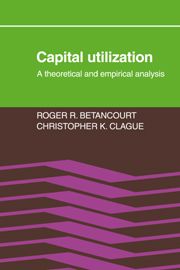Book contents
- Frontmatter
- Contents
- List of tables and figures
- List of propositions
- Preface
- Glossary of symbols
- Introduction
- 0 A preliminary view of capital utilization
- Part I Shift-work and the theory of the firm
- 1 Cost minimization
- 2 Specific functional forms: additional results
- 3 Profit maximization
- Part II Estimation
- Part III Results
- Part IV Implications
- References
- Index
1 - Cost minimization
Published online by Cambridge University Press: 05 March 2012
- Frontmatter
- Contents
- List of tables and figures
- List of propositions
- Preface
- Glossary of symbols
- Introduction
- 0 A preliminary view of capital utilization
- Part I Shift-work and the theory of the firm
- 1 Cost minimization
- 2 Specific functional forms: additional results
- 3 Profit maximization
- Part II Estimation
- Part III Results
- Part IV Implications
- References
- Index
Summary
In the introductory chapter we indicated the reasons for focusing on the decision to work shifts at the time of the investment decision, that is, before a plant is built. The shift-work decision then involves the simultaneous choices of the level of capital stock and the rate of utilization of that capital stock. Throughout this book this decision will be formulated in terms of choosing an optimal system of operation (i.e., a single-shift, double-shift, or triple-shift system) and an optimal level of capital stock. Thus a choice is made with respect to a discrete variable and a continuous one simultaneously. There are two reasons underlying this approach. First, we believe it corresponds closely to the actual decision-making process. Second, it facilitates the analysis considerably without eliminating any theoretical insights obtainable by formulating this process in terms of two continuous variables. On the contrary, it brings out some important aspects of the decision that can be easily overlooked in a continuous formulation.
It will be assumed in this chapter that the level of output to be produced during the day is stable and remains the same regardless of which system of operation is used. This assumption converts the decision problem into a cost-minimization problem for all three systems of operation. Whatever objectives the firm may have, the considerations involved in comparing the costs of all systems at every level of output will always play a major role in the choice between systems.
- Type
- Chapter
- Information
- Capital UtilizationA Theoretical and Empirical Analysis, pp. 11 - 23Publisher: Cambridge University PressPrint publication year: 1981

